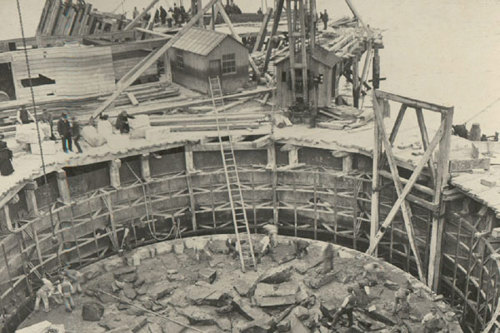West footpath/cycleway is currently closed for essential maintenance, please use the east footpath/cycleway.
Access Restrictions
Building the Forth Bridge
The Briggers
Although work on the foundations of the Forth Bridge started in February 1883, work at the site had begun in 1882 with the construction of steel fabrication workshops on the south side of the river.
At the peak of work, about 4,600 men were employed in building the Forth Bridge. They were known as 'the Briggers'.
It was long said that 57 died during the building of the bridge, although recent research by local historians indicated 73 would be a more accurate figure. The number of injuries is unknown, although one log book of accidents and sickness had 26,000 entries, and hundreds of workers were said to have been left crippled by serious accidents.

Efforts were made to look after the welfare of the men, however. Safety boats saved eight men from drowning. Boots and waterproofs were supplied to men working on the foundations, with thick woollen jackets, overalls and waterproof shoes given to those in superstructure work. Shelters and heated dining rooms were provided on-site and both workers and employers contributed to a sickness and accident fund. Wages on the project were also above average for all classes of worker.
During the seven years of construction, work was carried out from almost 100 feet below the surface of the water to over 300 feet above the surface.
Picture courtesy of National Records of Scotland Ref: NRS GD1/1346/3 page 2, 1885, May: Forth Bridge works: Central line of bridge, No.97, in: Photographs and drawings of Forth Bridge Works, vol. III
The first three years were spent building the granite piers on which the bridge was to be supported. This was done by sinking caissons – great wrought iron cylinders – to the sea bed and pumping them out so that men could work on the floor of the Forth, creating foundations and building up the piers. This was dangerous and unpleasant work and, in two of the caissons the depth was such that water had to be kept out by filling the working chamber at the bottom with compressed air, the men going through airlocks to get to their work.
Work on the superstructure got underway in 1886 and the growing structure became a site of wonder as it grew out from the piers, growing first upwards as the towers were completed, and then outwards as the cantilevers stretched out to meet one another, seemingly defying gravity as they did so.
The bridge was completed in December 1889 and the following month it underwent load testing. Two trains, each comprising three locomotives and 50 wagons loaded with coal (weighing in at a total of 1,880 tons for the two – twice the design load of the bridge) were driven slowly out onto the bridge, stopping frequently for measurements to be taken.
In February the first complete crossing of the bridge took place, with a train carrying the chairmen of the various railway companies involved. On March 4, 1890, the Forth railway bridge – known ever as simply The Forth Bridge – was officially opened by the Prince of Wales, later King Edward VII.



